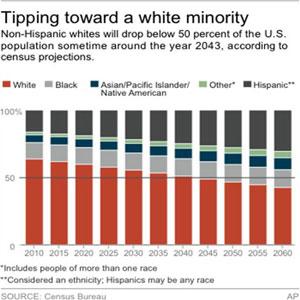
WASHINGTON (AP) - For the first time, America's racial and ethnic minorities now make up about half of the under-5 age group, the government said Thursday. This historic shift shows that young people now emerge at the forefront of sweeping racial and class changes.
The new census estimates, a snapshot of the U.S. population as of July 2012, comes a year after the Census Bureau reported a fall to minority status in white babies. Fueled by immigration, a rapidly growing rate of racial and ethnic births, particularly among Hispanics, illustrates much higher numbers than those of whites.
Based on current rates of growth, white children in the under-5 age group will tip to a minority this year or next, Thomas Mesenbourg, the Census Bureau's acting director, said.
The government also projects that in five years, minorities will make up more than half of the children 18 or younger. Not long after, the total U.S. white population will begin an inexorable decline in absolute numbers, due to aging baby boomers.
The imminent tip to a white minority among young children adds a racial dimension to government spending on early-childhood education, such as President Barack Obama's proposal to create significant expansion of pre-kindergarten for lower-income families. With the nation's demographic changes already stirring discussion as to whether some civil rights-era programs, such as affirmative action in college admissions, many question whether to retool the focus more on income rather than race and ethnicity. The Supreme Court will rule on the issue this month.
Studies show that gaps in achievement by both race and class begin long before college, suggesting that U.S. remedies to foster equal opportunity needs to reach children earlier in life.
 "The educational system is likely to be the most widely used and most acceptable policy tool we have for equalizing life chances. But it does not seem so far to (have) achieved this goal," said Timothy Smeeding, an economics professor at the University of Wisconsin-Madison who specializes in income inequality. "This specter of unequal opportunity may be the biggest negative social outcome of the continuing American inequality boom."
"The educational system is likely to be the most widely used and most acceptable policy tool we have for equalizing life chances. But it does not seem so far to (have) achieved this goal," said Timothy Smeeding, an economics professor at the University of Wisconsin-Madison who specializes in income inequality. "This specter of unequal opportunity may be the biggest negative social outcome of the continuing American inequality boom."
The gap between rich and poor in the U.S. has now stretched to its widest since 1970, making opportunities to reach the middle class increasingly difficult.
Longer-term changes in family structure, such as a decline in marriage, have led to a rise in single-mother households across all racial groups, with the fastest growth now occurring among whites. More than 40 percent of newborns are now born out of wedlock, in families more likely to be low income.
The latest census numbers show:
- The population younger than 5 stood at 49.9 percent minority in 2012.
- For the first time in more than a century, the number of deaths now exceeds births among white Americans. This "natural decrease" occurred several years before the government's original projection, a sign of the white population decline soon to arrive. For now, the white population is still increasing slightly, due to immigration from Europe.
- As a whole, the nonwhite population increased by 1.9 percent to 116 million, or 37 percent of the U.S. The fastest percentage growth is among multiracial Americans, followed by Asians and Hispanics. Non-Hispanic whites make up 63 percent of the U.S.; Hispanics, 17 percent; blacks, 12.3 percent; Asians, 5 percent; and multiracial Americans, 2.4 percent.
- About 353 of the nation's 3,143 counties, or 11 percent, are now "majority-minority." Six of those counties tipped to that status last year: Mecklenburg, N.C.; Cherokee, Okla.; Texas, Okla.; Bell, Texas; Hockley, Texas; and Terrell, Texas.
- In 2012, 13 states and the District of Columbia had an under-5 age population that was "majority-minority," up from five states in 2000. In 25 states and the District of Columbia, minorities now make up more than 40 percent of the under-5 group.
- Among the under-5 age group, 22 percent live in poverty, typically in more rural states like Mississippi, Arkansas, and Louisiana. Black toddlers were most likely to be poor, at 41 percent, followed by Hispanics at 32 percent, and whites at 13 percent. Asian toddlers had a poverty rate of 11 percent.
"More so than ever, we need to recognize the importance of young minorities for the growth and vitality of our (future) labor force and economy," said William H. Frey, a demographer at the Brookings Institution who analyzed the census data.
 Smeeding's analysis of the latest research and data on social mobility, provided to The Associated Press, shows that a child's achievement varies widely depending on a parent's education and income. The reason: More educated parents tend to have fewer children and generally earn more money than before, allowing them to spend larger amounts of time or money on a child's development, including music or art classes, extra tutoring, travel, and summer camps.
Smeeding's analysis of the latest research and data on social mobility, provided to The Associated Press, shows that a child's achievement varies widely depending on a parent's education and income. The reason: More educated parents tend to have fewer children and generally earn more money than before, allowing them to spend larger amounts of time or money on a child's development, including music or art classes, extra tutoring, travel, and summer camps.
The gaps in achievement tend to emerge early in childhood, continuing through high school, and disparities are especially evident in SAT admission scores. College Board data shows that average scores spread as wide as 130-140 points in each of the reading, math, and writing sections for a student with a family income of less than $20,000, compared to students with a family income exceeding $200,000.
About 40 percent of whites age 25-29 graduate from college, compared with 15 percent for Latinos, and 23 percent for blacks.
Obama proposed expanding pre-K education for any 4-year-old whose family income was below twice the federal poverty rate, or $46,000 for a family of four. That is an increasingly minority age group that would benefit from what Obama calls the single most effective way to boost educational outcomes.
To pay for the plan, the government would add nearly $1 per pack federal cigarette tax. But at a time of strapped federal budgets, Republican lawmakers are reluctant to expand the scope of government or raise new taxes. Medicare and Social Security costs due to aging of the mostly white baby boomer generation also add to the government burden.
A recent Rutgers University study found that state funding for pre-K programs hit its largest drop ever last year, with states now spending less per child than a decade ago.
Online: Census Bureau
Copyright 2013 The Associated Press.
